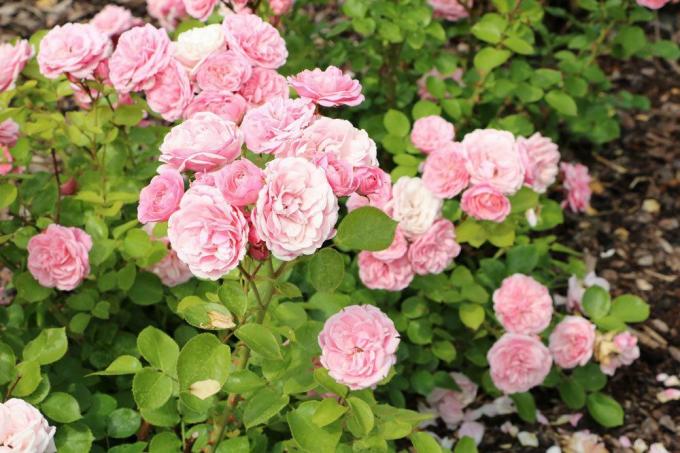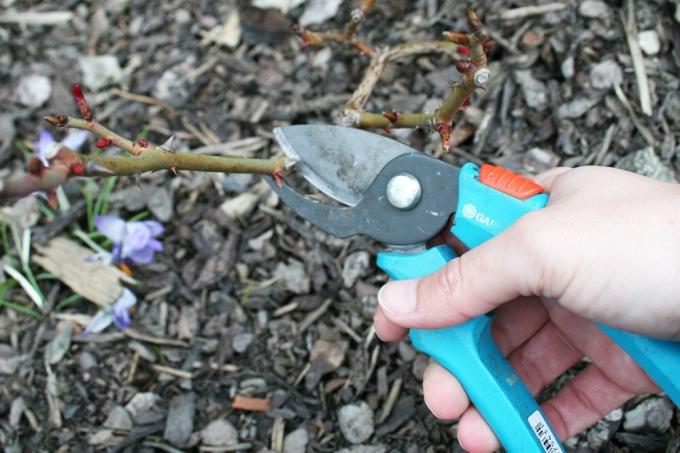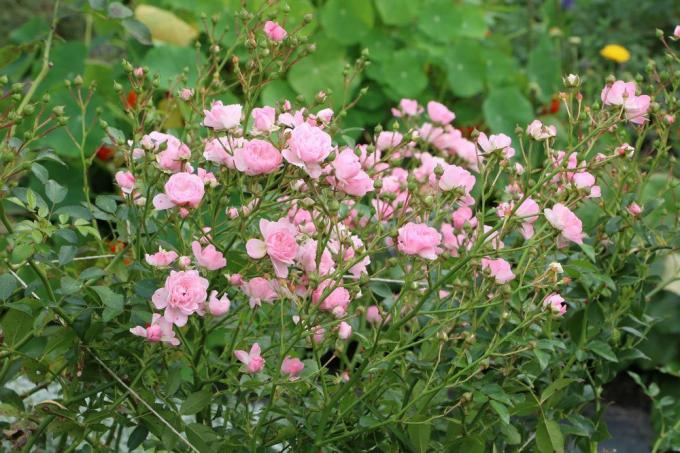
table of contents
- Ground cover roses
- No annual pruning necessary
- time
- Cut ground cover roses
- instructions
- care
- Location and soil conditions
- to water
- Winter protection
Roses - the "queens of flowers" are at home in almost every garden. They come in different varieties and types. The ground cover roses are very popular. The undisputed classic among them “The Fairy Roses”. They bloom more often and enchant with their small, pink flowers that stand together in umbels. These ground covers are very robust, frost hardy and cut compatible. Even if they do not make great demands on the care, there are a few things that should be taken into account.
Ground cover roses
This rose variety is a reliable bloomer from June to the first frost. Your growth is more in width than in height. Normally it is between 50 and 70 cm high and just as, if not a little wider. The bis are in small clusters
2.5 cm large pink, double flowers together. The long shoots sink to the ground and can thus cover larger areas. 25 or more buds can appear on one shoot alone. In summer, the dark green, glossy foliage is barely noticeable beneath the flowers. The flowers are rainproof and, unlike other roses, rose hips do not form after they have faded. "The Fairy" is not only a beautiful eye-catcher in the garden, it is
- pretty tough
- resistant to fungal diseases
- tolerates heat
- more often blooming
- frost hardy
- very easy to care for and
- extremely easy to cut
The ground cover can be planted as a hedge or in groups. 4 to 5 plants are placed on one square meter. Once planted in one place, they hardly need any maintenance. However, it should be cut back from time to time so that its willingness to flower and healthy growth is stimulated.

tip: When grown freely, the "fairy rose" can reach a height of 150 cm, which makes it a good standard rose - a popular eye-catcher, especially in small gardens. But it can also be planted in pots.
No annual pruning necessary
The pruning of the ground cover roses is limited to a minimum compared to other rose varieties. However, it can sometimes be a real show of strength. Usually, cutting the ground cover every three to four years is sufficient. Of course, you are free to make an annual cut. The cutting of the "fairy roses" causes
- the stimulation of a loose growth
- Formation of a rich flower pile and
- Strengthening the resistance to diseases
Not to be forgotten is of course the wonderful decorative aspect. However, the time for the pruning and correct instructions are always important.
tip: “The Fairy”, as well as the “Snow Ballet” and “Swany” varieties, have a particularly beautiful and compact growth when pruned annually.
time
As with other rose varieties, the shoots should always be cut at the time of the forsythia bloom, i.e. from March depending on the weather. The measure should begin before the roses begin to sprout. Continuous frosts must no longer occur during the day.
In addition, pruning in autumn is also possible, but should be avoided if possible. It must be taken into account that the freshly cut shoots can freeze back a lot in winter. However, an autumn pruning can be done without consequences in mild areas, for example in wine-growing areas.
Cut ground cover roses
The ground cover is quite easy on pruning. However, it can sometimes cost a lot of strength. It is therefore necessary that special sharp scissors are used. You can even use hedge trimmers to cut, especially if you want to rejuvenate the roses. The use of the hedge trimmers mentioned is recommended, especially for large rose beds.
The way of cutting is always the same for an annual cut and a cut back after three to four years. Only the amount should be taken into account
- annual pruning to a height of 30 cm
- every three to four years at a height of 15 cm

tip: Various ground cover roses are offered in stores without roots. You don't have a finishing department. These roses should simply grow unhindered for three to five years. Then cut back to 20 cm above the ground.
instructions
In principle, it does not matter whether this year's shoots or shoots from last year are cut. With these roses, it does not play a role in comparison to other bed or hybrid tea roses. The following must then be observed when cutting
- generally cut out frozen, dead, dried up or diseased shoots
- can be recognized by the brown color of the bark
- continue to remove all rose galls
- these are "sponges" on the shoots, breeding grounds for gall wasps
- Remove all wild shoots and weak shoots below the grafting point
- All whip-like, strong shoots shortened by a third
- cut to a maximum of 3 to 4 eyes (dormant buds)
- Place scissors 5 mm above one eye facing outwards
- The cut should be made at an angle to the opposite side
- clear out if necessary
- to do this, cut out one or two old main shoots just above the ground
Annual pruning is required if the roses are to stay really low. The plants should be put on stock every five years. In other words, there is a Radical cut. The roses are stimulated to form new shoots and of course there is a lush bloom.
It should also be mentioned that Wild shoots, dry or diseased shoots can be cut out throughout the year, including in summer. During the summer months, withered parts of the flower should also be removed regularly. This stimulates the shrub to new shoots. To do this, simply cut off faded flowers with two fully developed leaves underneath with sharp scissors.
tip: When cutting side shoots and branches, no stumps may remain. These can encourage the penetration of pathogens.
care
Even if ground cover roses such as “fairy roses” do not have any special demands on care, this should not be completely neglected. However, the ground cover requires less attention compared to other roses. However, some work is still necessary so that every year from spring to late autumn a sea of flowers makes the garden shine. Not to be forgotten is the right choice of location and the appropriate nature of the soil.
Location and soil conditions
The perfect location and the composition of the soil are of course very important for good growth and the health of the ground cover roses. Only then can the roses really develop their splendor. The choice of the future location should be made carefully before planting. Good soil preparation is just as important. Like all roses, these magnificent ground cover plants love a sunny spot in the garden
- tolerate heat, but not blazing midday sun
- Partial shade is also tolerated well
- however, there should be a few hours of sunshine
- airy place
- wet leaves must be able to dry quickly
- Otherwise there is a risk of disease
- strong drafts are badly tolerated
- need deep, humus-rich and nutrient-rich soil
- Soil must be permeable to water
- Avoid waterlogging
- best suited medium-heavy, slightly loamy soil with a neutral pH value
If the soil does not meet the requirements, ripe compost soil can be incorporated to improve it. In addition to the location and the nature of the soil, watering, soil cultivation and winter protection must not be forgotten in maintenance.
to water
Ground cover roses are deep-rooted. Watering is usually only necessary in extremely dry conditions. Otherwise, the fine roots draw water and nutrients from the deeper regions of the soil. However, these long roots have to develop first. For this reason, more intensive watering is necessary in the first year after planting. Otherwise, water should only be poured when the soil has dried up to a depth of 10 cm. A folding rule can be used for checking.
The application of lawn clippings or bark mulch around the plants can be advantageous. The height of the layer should not exceed 3 to 4 cm. Through this measure, the soil remains moist, loose and slightly porous for longer, so it retains a crumbly structure.
tip: Bark mulch binds nitrogen from the soil, which is necessary for its decomposition. The ground cover would then lack this as a nutrient. It is therefore advisable to work horn shavings into the soil under the mulch layer as an additional nitrogen supplier.
In addition, sufficient fertilization and loosening of the soil are necessary for healthy plants and a long flowering period.
- Fertilization with slow release fertilizers or organic fertilizers
- Nutrients are released slowly during the growing season
- Regular loosening of the soil prevents evaporation of soil water
- The soil becomes airy and permeable
As mentioned earlier, cleaning out withered flowers should not be forgotten. It not only stimulates new bud formation, but also prevents infestation with diseases.
Winter protection
In principle, these ground cover plants are frost hardy and actually cope well with low temperatures below freezing point. However, the finishing point in particular is sensitive to the cold. Appropriate winter protection should therefore be applied.
- in late autumn pile up plants 20 cm high
- use bark mulch, compost or loose garden soil
- high quality potting soil is also suitable
- In addition, put spruce twigs loosely around the bushes
- remove winter protection in the second half of March
- piled earth etc. rake wide
- Loosen the soil and fertilize
- start cutting back depending on the weather



